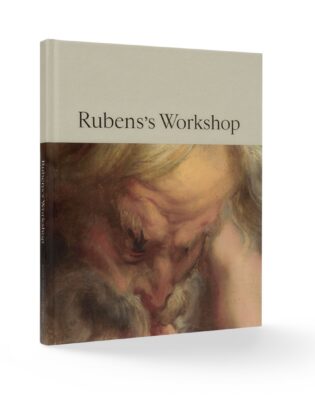This is the catalogue of an exhibition held at the Prado between October 2024 and February 2025. It was organized by the Curator of Flemish paintings at the Museum, Alejandro Vergara, and is the product of his long and thoughtful study of the Prado’s outstanding collection of paintings by Rubens. Within this group are paintings by Rubens himself (for his Habsburg patrons) and paintings with more or less participation by members of his Antwerp studio. As Vergara notes, it is remarkable, given Rubens’s contemporary fame and enormous success, how relatively little we know about the working of his studio. We are even unsure precisely who was in the studio. He lists the best-known names but omits others including, for example, Daniel van den Dyck, in the studio in the mid-1630s, who then sought his fortune in Venice.
Vergara outlines what we know of the studio and discusses Rubens’s well-known correspondence with Dudley Carleton in which the artist draws a clear distinction between works by his own hand and those begun by an assistant and retouched by the master. Particularly valuable in the long introductory essay is his account of the phases in the creation of a painting in the workshop in which he draws heavily, with fulsome acknowledgement, on recent work by Arnout Balis and Nico Van Hout. There are sections on priming, drawing in black chalk and paint, dead color, the application of color, retouching and varnishing. He pays special attention to the question of the extended drying times of paint which made it not just possible but necessary to work on a number of paintings simultaneously. He makes frequent reference to Spanish authors – Carducho, Hidalgo, Pacheco, Palomino – whose remarks on technique shed light on Rubens’s contemporary practice.
Vergara then looks at six particular cases in the Prado. The Achilles Discovered by Odysseus and Diomedes has long been thought to be the painting mentioned in Rubens’s letter of March 1618 to Carleton as “made by the best of my pupils, and the whole retouched by my hand” and that the pupil in question was Van Dyck. Vergara follows the evolution of the painting in the stages outlined in his introductory essay. He then deals with the questions of the identification of the painting with that in the Carleton letter and as the work of Van Dyck. He recants his former opinion (in the Early Van Dyck exhibition catalogue of 2012) that it is not by Van Dyck. He concludes that “the painting is the result of a workshop system where someone other than the master was responsible for a large portion of this painting.” Suffice it to say that this reviewer concurs in Balis’s opinion, quoted here, that it is plausible that it is the Carleton picture and that it is “an early Van Dyck painting retouched by Rubens.”
Vergara’s second case study is of the oil sketch for The Death of Decius Mus, of which the tapestry cartoon is in the Liechtenstein Collections. It is the largest oil sketch by Rubens (and there may well have been a smaller initial oil sketch). Vergara considers this modello to be painted by “someone other than Rubens” but retains the attribution to Rubens and workshop, arguing that the figure of winged Victory at the top was added by Rubens himself. He also quotes approvingly Baumstark’s surprising idea that the finished cartoon was painted by Jordaens in his own workshop.[1] The present reviewer believes that the Prado modello is by Rubens and the cartoon was largely painted by Van Dyck while he was in Rubens’s workshop.
The third case study is the wonderful small sketch or bozzetto, generously lent by the Boijmans Van Beuningen Museum in Rotterdam for The Education of Achilles tapestry and the workshop modello in the Prado (persuasively attributed to Erasmus Quellinus by Hans Vlieghe[2]) which was subsequently retouched by Rubens. Vergara then discusses three of the Torre de la Parada paintings: he argues that the Saturn Devouring One of His Children is by Rubens himself, Democritus is painted nearly entirely by a collaborator and Mercury and Argus is “a combined effort.” Next, in this section, he discusses The Recognition of Philopoemen, a collaboration between Rubens and Frans Snyders, painted in about 1609/10, in which he detects “minor re-workings” by Rubens in Snyders’s section. Finally, in an instructive comparison, he considers the portrait of Anne of Austria in the Prado and an impressive workshop version now in a private collection in Vienna. (It had been in the Marlborough collection at Blenheim Palace around 1700 and was deaccessioned by the Metropolitan Museum in 1979).
The third and final part of the catalogue is the transcription by Vergara of a conversation between him and the painter Jacobo Alcalde Gibert in which they discuss Rubens’s painting technique while Gibert is making a copy of the Mercury and Argus, following Rubens’s technical procedures. Photographs of the various stages of the painting’s progress are illustrated. A number of important points emerge from this conversation: the fact, for example, that the charcoal drawing, being dry, largely falls off the canvas and leaves almost no trace (as Van Mander describes). There are also illuminating remarks about the drying times of various paints, the crucial importance of the dead color phase and the completion of landscape before the figures were begun.
Vergara is to be congratulated on a major contribution to the study of Rubens’s technique and the functioning of his workshop in this fine catalogue.
Christopher Brown
University of Oxford
[1] Reinhold Baumstark and Guy Delmarcel, Rubens. Subjects from History: The Decius Mus Series (Corpus Rubenianum Ludwig Burchard, XIII, 2), London – Turnhout, 2019.
[2] Hans Vlieghe, “Erasmus Quellinus and Rubens’s Studio Practice,” The Burlington Magazine, 119, 1977, pp. 636-643.
